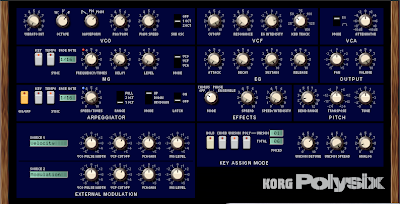 (Click the above image to enlarge and see settings...)
(Click the above image to enlarge and see settings...)It seems like it is simply impossible to buy a synth these days without having some sort of trance lead among the presets. In fact, more likely than not, there are tons of them. It's become the most over-used sound in music for the past decade or so. The trance lead is to the 2000's what the dreaded DX-7 Rhodes patch was to the 1980's. So why bother learning to program one? Well, aside from it always being a good idea to know what makes a sound tick, the lowly trance lead can be the starting point for a myriad of other cool sounds. So against my better judgement, here's how you do it.
You can use any synth that offers pulse width modulation (PWM) and a unison mode, but I'll be using Korg's simple and great-sounding Polysix softsynth. The default sound on this softsynth is Fat Line Bass, so if you want to follow along, that's your starting point. Alright, so in case you're not familiar with it, pulse width modulation is, as the name suggests, simply modulating the width of a pulse wave. If you've messed with the width of a pulse wave before, you know that at wider settings you essentially get a nice, hollow square wave, and at narrower settings, the wave begins to take on a more nasal tone (think of an oboe or banjo). The magic happens when you modulate the width in real time using an LFO. When you are sweeping back and forth from a wide pulse width to a narrow one, you get a very nice, warm, fat tone sort of like a detuned sawtooth wave.
1. So our first order of business will be to set the Polysix's WAVEFORM to PWM. If you play a few notes, you'll hear pretty much your standard square wave. Let's change that and get into slightly fatter territory. Push the PW/PWM value up to between 7 and 8, and the PWM SPEED up to between 6 and 7. The tone should be a bit thicker at this point.
2. We want this to be nice and bright, so head on over to the VCF section and turn the CUTOFF value all the way up to 10.
3. The tone is getting closer, but our envelope isn't quite right. For most lead sounds, you want what is essentially an organ type envelope - you press a key and it sustains as long as you hold it, and when you let go, it stops sounding immediately. So go ahead and knock the SUSTAIN level in the EG section all the way up to 10, and bring the RELEASE value down to 0.
4. Finally, head down to the KEY ASSIGN MODE section and make sure UNISON is selected. This will sound several notes at once each time you hit the key for a thicker sound. Turn UNISON DETUNE up to around 7, and UNISON SPREAD up to 10. Play a few notes and there it is, the plague of all music kind!
The aim of most trance leads is to sound as big and impressive as possible, so you'll want to feed it through some reverb and a nice delay for best results. From here, you can easily dial up a whole slew of different sounds. Mess with different envelope settings and filter cutoff settings to create pads, basses and other synthy tones. Try messing around with the PW/PWM and PWM SPEED values for variations on the same theme.
If you've done everything correctly, you should have something that sounds like this:




















3 comments:
Pretty sure you want that title to read "TRANCE" lead, not "TARNCE" lead.
I'm enjoying this series. Keep it up!
No, the 'Tarnce' spelling was a joke because of how frequently there are 'HOW DO I MAKE TARNCE MUSIC?" posts on KVR and other online forums that feature that misspelling. Good eye,though. : )
oooh where are my glowsticks???
Post a Comment